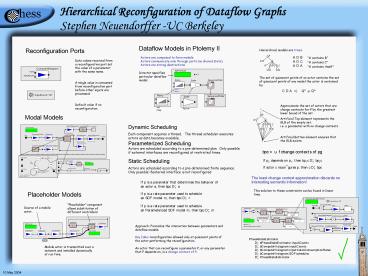Hierarchical Reconfiguration of Dataflow Graphs - PowerPoint PPT Presentation
1 / 1
Title: Hierarchical Reconfiguration of Dataflow Graphs
1
Hierarchical Reconfiguration of Dataflow Graphs
Stephen Neuendorffer -UC Berkeley
Dataflow Models in Ptolemy II
Reconfiguration Ports
Hierarchical models are trees.
A
Actors are composed to form models. Actors
communicate only through ports (no shared
state). Actors are strong abstractions
A contains B A contains C A contains itself
Data values received from a reconfiguration port
set the value of a parameter with the same
name. A single value is consumed from
reconfiguration port before other inputs are
processed. Default value if no reconfiguration.
B
C
Director specifies particular dataflow model.
The set of quiescent points of an actor contains
the set of quiescent points of any model the
actor is contained by.
Approximate the set of actors that are change
contexts for P by the greatest lower bound of the
set. Artificial Top element represents the GLB of
the empty set. i.e. a parameter with no change
contexts Artificial Bottom element ensures that
the GLB exists.
init step
factor
A
Modal Models
B
C
Dynamic Scheduling Each component acquires a
thread. The thread scheduler executes actors as
data becomes available. Parameterized
Scheduling Actors are scheduled according to a
pre-determined plan. Only possible if external
interfaces are reconfigured at restricted
times. Static Scheduling Actors are scheduled
according to a pre-determined finite sequence.
Only possible ifexternal interface is not
reconfigured
The least change context approximation discards
no interesting semantic information!
This solution to these constraints can be found
in linear time.
Placeholder Models
Placeholder component allows substitution of
different controllers
Source of a mobile actor.
Approach Formalize the interaction between
parameters and dataflow models. Key Idea
reconfiguration allowed only at quiescent points
of the actor performing the reconfiguration. An
actor that can reconfigure a parameter P, or any
parameter that P depends on, is a change context
of P.
Mobile actor is transmitted over a network and
installed dynamically at run time.
10 May 2004

